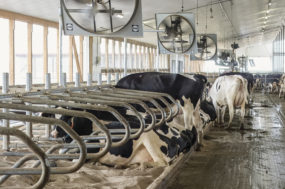There has been a lot of focus in recent years on the amount of methane (CH4) emissions produced by dairy cows. In 2009, the Innovation Center for U.S. Dairy set a voluntary goal of reducing enteric methane emission levels 25 percent by 2020, and last year California announced regulation requiring a 40 percent reduction in whole-farm methane emissions between 2013 and 2030.
It’s safe to say the issue isn’t going away, and it probably shouldn’t. Research has shown a correlation between reduced methane emissions, specifically enteric methane, and improved feed efficiency and milk production.
Enteric methane arises from the digestive process in the gastrointestinal tract and actually represents an energetic loss to the animal. Enteric methane accounts for 50 to 60 percent of a dairy’s emissions, while the remaining 40 to 50 percent is generated in manure- handling systems.
For U.S. dairy operations, total methane (enteric plus manure) will range from about 1.7 to 3.7 pounds per milk cow per day and includes the methane from non-milking animals (dry cows and replacement heifers). However, it’s more important to look at methane per pound of milk. Cows that produce more milk per day are not only more feed-efficient but also produce less methane per pound of milk.
In 2016, U.S. dairy operations produced approximately 210 billion pounds of milk that went into dairy products for consumers and exports. It would take 67 percent more cows to produce that amount of milk if the cows average 15,000 pounds per year versus 25,000 pounds per year (Table 1). They also would produce 30 percent more methane.

It’s been estimated that improvements in dairy cattle nutrition and feeding can easily increase feed efficiency from 1.4 to 1.5 pounds of milk per pound of feed, with a corresponding 6 to 8 percent decrease in methane per pound of milk. However, it’s not as simple as eliminating a few offensive ingredients. Methane production isn’t simply a matter of the individual feedstuffs but is a function of the whole ration and intake level.
Rations that have more forage and high-fiber byproducts (corn gluten feed, soyhulls, cottonseed hulls, etc.) will produce more methane per pound of feed than rations with high starch levels.
It is feasible to make ingredient changes and lower methane production without negatively impacting rumen function, milk components or cow health. For example, lowering neutral detergent fiber determined on an organic matter basis as a percent of dry matter from 32 to 28 would be expected to reduce methane by 5 percent without compromising rumen function or milk components.
However, more drastic changes in dairy diets can have negative consequences. While finishing beef diets containing 85 to 90 percent grain produce significantly less methane than dairy diets, we wouldn’t want to feed them to our cows.
The other drawback with ingredient changes is that the reduction only lasts while that diet is being fed – and isn’t long-term. Also, ingredient changes may have an impact on manure production, nutrient management (especially phosphorus) and other greenhouse gas emissions.
A feed that originates in the Midwest, for example corn grain or soybean meal, has more greenhouse gases associated with its transport to a Western dairy than locally grown forages.
Reductions in one area of greenhouse gas production in a dairy operation like enteric methane can result in increases in other areas like manure methane or greenhouse gases associated with feed production. We have to balance these trade-offs.
Instead of trying to reduce enteric emissions, our real focus should be improving whole-herd feed efficiency. Improving feed efficiency is a win-win. As milk production improves, so does profitability, and now we are realizing the added benefit of reducing enteric emissions.
There are several areas that have vast potential to help increase whole-herd feed efficiency, such as improving forage quality, genetic selection and controlling dry cow and heifer replacement numbers. Lower culling in the milking herd combined with lower calf and heifer mortality can have a very positive impact on profitability and lower enteric methane emissions simultaneously.
Even the cow with the best genetics and quality forage will never reach its maximum production capacity and conversion efficiency if growth and development were compromised as a calf and heifer. Think about your calf and heifer nutrition program today: Is it focused on full development or is it more of an afterthought?
In 2016, a new world record for milk production by a Holstein was set at 77,480 pounds, but the average production remains around 23,000 pounds. This vast disparity illustrates how much room we have for improvement as an industry in managing and feeding cows so they can achieve their full genetic potential.
Work with a whole-herd nutritionist to design a feeding program that focuses on improving feed efficiency by starting on day one of a calf’s life and continuing through until it calves in for the first lactation, when it can efficiently convert feed to milk components.
We wouldn’t sign up a teenager to run a marathon without proper training, so we can’t expect a heifer to enter the lactating herd and produce maximum results if we haven’t invested in the heifer’s development.
As we sharpen our focus on improving whole-herd feed efficiency through nutrition and management, we will reap a multitude of benefits including healthier animals, improved transitions and reduced culling and death loss, in addition to the improved productivity and decreased methane emissions. As a result, the U.S. dairy industry will have an engaging positive sustainability and animal welfare story to share with consumers. ![]()
*Dr. Knapp was a member of the Cow of the Future advisory group.
Joanne Knapp is a Provimi Dairy Nutritionist and works with Cargill Premix and Nutrition.





